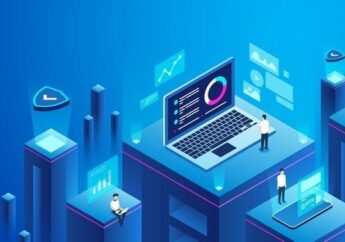The Future Of Work: Adapting To Technological Shifts
by Abdul Aziz Mondal Technology Published on: 27 May 2024 Last Updated on: 08 August 2024

Technology continues to observe a paradigm shift in the present time.
From artificial intelligence to Cloud computing, from Augmented reality to the Internet of Things, these advancements are reshaping various aspects of daily life.
Furthermore, they are bringing change in the way people work. This era of rapid growth in technology helps in transforming traditional job roles. At the same time, they help in developing new opportunities that were unimaginable a few decades ago.
Here, we take a look at how technology is transforming, like business process automation services, on the future of work. Moreover, by examining technology and the future of work through innovations, businesses can meet the challenges.
The article, in additipn sheds light and adds a perspective on the evolving work landscape. Also, the role of technology in understanding its implications and exploring businesses’ horizons and employees’ adaptability finds detailed discussion.
The Evolution Of Technology And Future Of Work
The workplace today has undergone a sea change over time. Before, the time frame of the office setup was rigid; that is, it had dedicated working hours. All these changes are slowly, with time, replaced with the help of the digital workplace.
Technology helps offer far greater flexibility. Remote work was once a topic of discussion and quite rare. But with the advent of new technology, businesses adapt to changing circumstances and attain ease of work.
Technological Shifts Reshaping Work
Technology is evolving greatly, and it is rapidly shaping the approach to the modern workspace. However, we discuss some of the major technology variants that have been successful in ushering in the change.
Artificial Intelligence (AI)
Artificial intelligence is bringing about a revolution in the use of technology. Moreover, various industries are using it to enhance their decision-making. Moreover, they can successfully use technology to improve efficiency in business.
From advanced data analytics to customer service chatbots, applications of AI are vast and expanding continually.
Internet Of Things (Iot)
IoT connects devices and systems, has been successful in reciprocating data and enabling security.
This connectivity provides real-time insights and better operational efficiency whi, which are key to making the best decisions in the workplace.
Cloud Computing
Cloud computing offers scalable resources and services over the Internet, reducing the need for physical infrastructure. It enables businesses to access data and applications from anywhere, fostering collaboration and flexibility.
Understanding The Implications For Work Processes
Every new development, especially in technology, takes place in response to sore issues.
Simply put, the new technology that is developing has the main motive, i.e., changing the landscape of modern workspaces and attaining ease of working. Here are the changes that take place post-induction of new technology; we mean the implications.
Automation of Routine Tasks
Technological advancements are automating routine and repetitive tasks, allowing employees to focus on more strategic and creative aspects of their jobs. This shift increases productivity and job satisfaction.
Enhanced Connectivity and Collaboration
Technologies like IoT and cloud computing enhance connectivity, enabling seamless collaboration across teams and locations. This interconnectedness fosters innovation and accelerates project timelines.
Flexibility And Mobility
The digital era promotes flexibility and mobility, with remote work becoming a viable option for many. Employees can work from anywhere, leading to better work-life balance and increased job satisfaction.
The Role Of Automation Service
Automation, without doubt, has brought in a paradigm shift in the way business takes place.
Business process automation services use technology to perform repetitive tasks and streamline operations.
This approach reduces manual effort, minimizes errors, and enhances overall efficiency. Thus, the role of technology and the future of work becomes an important discussion point.
Streamlining Operations Through Automation
The present workplace is filled with its existent and imminent complexities. Hence, the role of technology becomes vital in streamlining operations.
It is setting new boundaries and making the work processes easier. Here’s a discussion on how automation is attaining its aims.
Automating Repetitive Tasks
Automation tools can handle repetitive tasks such as data entry, scheduling, and reporting. By offloading these tasks to machines, businesses can save time and reduce the likelihood of human error.
Improving Workflow Efficiency
Automated workflows ensure tasks are completed in a timely and consistent manner. This improvement in workflow efficiency translates to faster project completion and better resource management.
Enhancing Decision-Making With Data-Driven Insights
Decision-making using technology and the future of work is a major discussion point, and its discussion becomes pertinent under the present circumstances.
Leveraging Automation for Data Analysis
Automation services can process and analyze vast amounts of data quickly and accurately. These data-driven insights support informed decision-making and strategic planning.
Enabling Predictive Analytics
Predictive analytics powered by automation can forecast trends and identify potential issues before they arise. Hence, the proactive approach allows businesses to stay ahead of the competition and mitigate risks effectively.
Adapting To The Future Work Environment
When you discuss technology and the future of worke, the discussion of the adoption of it in the practical landscape finds pertinence.
Embracing Change
Embracing change through the use of new technology is definitely one of the benefits that stakeholders in business development are reaping in the present situation.
Flexibility in Work Arrangements
Adapting to technological shifts requires flexibility in work arrangements. Businesses must be open to remote work, flexible hours, and hybrid models to attract and retain talent in a digital age.
Upskilling And Reskilling The Workforce
As technology evolves, so must the skills of the workforce. Investing in upskilling and reskilling programs ensures employees remain relevant and can effectively utilize new technologies.
Overcoming Challenges And Resistance
The role of technology and the future of work attains prominence when we discuss the most important point of removing the challenges.
Addressing Concerns About Job Displacement
The automation of tasks often raises concerns about job displacement. Hence, addressing these concerns involves transparent communication, offering retraining programs, and highlighting the new opportunities created by technological advancements.
Cultural Shifts And Change Management Strategies
Successful adaptation requires a cultural shift within organizations. Change management strategies, including leadership support and employee engagement, are crucial for fostering a culture that embraces innovation.
Collaboration And Innovation In A Digitally-Enabled Workplace
A collaborative workplace through innovation is undoubtedly one of the key attainments, say, a gift of the digitally enabled workplace.
Fostering Collaboration Across Teams And Locations
Technological tools facilitate collaboration across different teams and geographic locations. In addition, encouraging cross-functional teamwork and communication enhances creativity and problem-solving.
Encouraging Experimentation And Continuous Improvement
A digitally-enabled workplace thrives on experimentation and continuous improvement. Encouraging employees to try new approaches and learn from failures fosters a culture of innovation and resilience.
Use Of Technology In Education
The use of technology is key in the education sector and has brought change not only in developed countries but also in developing countries.
The role of technology was felt much before, and that is why the stakeholders invested heavily in developing them for the benevolence of the student community. The investments that the stakeholders made in technology development helped massively in reducing the skill gap of the students.
For example, you may be a late learner. But with the help of video tutorials on the internet platforms, you could rewind the videos a number of times to understand the subject from the core.
However, let us try to understand the role of technology in attaining this very end. These are the benefits the stakeholders addressed with the help of technology.
Moreover, people are reaping the benefits of technology, as its emphasis is on cross-functional developments. However, we discuss some of the key technologies that the education sector exploits to attain its aims.
Cloud Technology
Nowadays, schools integrate themselves with online software and keep their data in cloud storage.
Now, the students can easily solve team tasks and reciprocate information with the help of multimedia devices. Even cloud services like Google Deivers and Office356 have been effective in storing data, sharing information, and
Vr Technology
Virtual reality and augmented reality have been highly effective in bringing a new dimension to the classroom.
For example, students can encounter ancient dinosaurs and civilizations to get an idea of the times. We provide one of the most important examples of AR Technology: Pokemon GO.
Challenges And Risks
When you discuss challenging technology and the future of work, ther are challenges and risks galore. Integration of technology is not helpful all the time.
Firstly, the benefits of technology are not distributed equally to society, irrespective of sectors and economic feasibility. The students in Europe, the USA, and developing countries reap with AR, AI, and others. But unfortunately, students in the poorer nations do not have access to the same ease.
Secondly, when technology gains the upper hand, it incalculably negates and cuts down human involvement.
The induction of powerful machinery with automation reduces human labor. Most recently, the use of Chat GPT has brough is cutting human labor significantly. This development puts a huge question mark.
Conclusion
The future of work is being shaped by rapid technological advancements. Understanding and adapting to these changes is essential for businesses and employees alike.
By embracing technological innovations, streamlining operations through automation, and fostering a culture of flexibility and continuous learning, organizations can navigate the evolving work landscape and thrive in the digital era.




































































































All Comments
seosearchoptimizationpro
You'reresilient